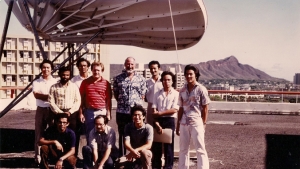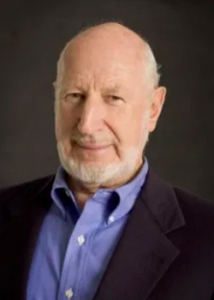The University of Hawaiʻi at Mānoa College of Engineering was the birthplace of a revolutionary wireless communication technology nearly 50 years ago, and the project that started it, ALOHAnet, has received a major international engineering honor.
On October 13, ALOHAnet was recognized by the Institute of Electrical and Electronics Engineers (IEEE) as an IEEE milestone—after a lengthy application and selection process—in a dedication ceremony at UH Mānoa’s Holmes Hall.

“ALOHAnet and the ALOHA protocols all developed right here have changed the world as one of the critical enabling technologies for the internet before it was called the internet,” UH President David Lassner said.
“It’s been unbelievable for me to be able to say that I have the opportunity to work at a place that can arguably be said to have given birth to our modern way of life, a lifestyle that is inextricably intertwined with the internet, cell phones, wifi and all other mobile technologies out there,” College of Engineering Dean Brennon Morioka said.
Governor David Ige, a UH Mānoa electrical engineering alumnus, said ALOHAnet is an example of how UH has shaped the future of Hawaiʻi.
“Clearly what ALOHAnet means to the internet and wireless communications is just another inspiration for all of us as we look forward to what the future will be,” Ige said.
ALOHAnet beginnings

All wireless communications today—including mobile, satellite, cellular and WiFi—utilize the protocol developed in the ALOHAnet system to establish an initial link. Debuted in 1971, ALOHAnet was the first system to transmit data into a computer using radio waves. ALOHAnet led to the development of Ethernet and personal wireless communication technologies.
Norman Abramson, one of the ALOHAnet founders, came to the UH Mānoa College of Engineering as a faculty member in 1968, just three years before ALOHAnet was launched. Abramson served as a professor of electrical engineering and chair of the Information and Computer Sciences Department until 1996. He then continued his work in education and the private sector.
Franklin Kuo was also a faculty member in the College of Engineering and spearheaded the ALOHAnet project with Abramson. Kuo credited other faculty members and graduate students who also worked to develop ALOHAnet. Kuo left UH Mānoa in 1975 for a career at the Pentagon in Washington, D.C. where he worked as the director of information systems.
“Whenever you pick up your telephone and make a phone call or use some other applications from that telephone, the very first thing you do is a packet comes from that telephone and the packet says ‘ALOHA,’” Abramson said. “I had the feeling back then that the ALOHA channel and the technology that we came up with would be used, but I had no idea it would be used so widely.”
Reaction to ALOHAnet milestone
The University of Hawaiʻi is the gift that keeps on giving, and it has been giving for 50 years and more,
—Vint Cerf
Google’s chief internet evangelist and “Father of the Internet,” Vint Cerf, commended Abramson and Kuo for triggering an extraordinary explosion of technology.
“The University of Hawaiʻi is the gift that keeps on giving, and it has been giving for 50 years and more,” Cerf said. “We benefit from that. Imagine the industries that have grown up around people who have learned skills from the University of Hawaiʻi.”
Charlie Bass was a UH Mānoa graduate student from 1968 to 1972. After earning his PhD in electrical engineering in 1972, Bass went on to have a career in education and the private sector. Bass expressed his deep gratitude for the groundwork laid by Abramson and Kuo in the classroom, and shared a lighthearted moment that he and Abramson had when Bass first arrived at UH Mānoa in 1968.
“I walked into Norm’s office, who was my primary contact at the time, and I laid out what I wanted to do and he listened and waited for a minute and said ‘you know, maybe you should leave time for surfing,’” Bass said. “I nearly fell over. The last thing I ever expected someone at the university to do was think about my leisure time or my mental health. It was a good start.”
—By Marc Arakaki
ALOHAnet dedication video by the College of Engineering

